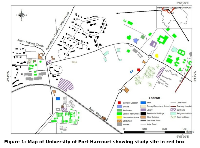Ecotoxicity potentials of residual paracetamol and personal care products (PCPs) in household waste in the University of Port Harcourt, Port Harcourt, Nigeria
Keywords:
Household waste, Pharmaceuticals and personal care products (PPCPs), residual paracetamolAbstract
This study evaluated the relative amount of Pharmaceutical and Personal Care Products (PPCPs) and paracetamol residues contained in household waste at the University of Port Harcourt, Port Harcourt, Nigeria. Residual paracetamol was analysed using a 6405 UV/Vis Spectrophotometer at the maximum wavelength (245nm) in 0.1N HCL. Student hostels had a mean paracetamol concentration of 0.67 mg/kg while the staff quarters recorded a mean concentration of 0.66 mg/kg. Solid waste analysis recorded 0.9 kg/capita/day and 1.1 kg/capita/day for the student hostel and staff quarters respectively. The student’s hostel recorded a mean percentage PPCPs value of 52.9% which was higher than that obtained in the staff quarters (45.9%) indicating that students disposed of more drugs in their waste than does the staff. The study showed that considerable amounts of PPCPs are disposed of in household waste at the study location and household waste is thus a viable pathway of PPCPs into the environment. Such practices could lead to the occurrence of the active ingredients of PPCPs in the environment with the potential to contaminate surface and ground water posing serious risk to human and ecologic health. It was recommended that appropriate return channels be established specially as a route for disposing of unused or expired drugs. Such routes should encourage stewardship of drugs by manufacturers from cradle to grave in an integrated green pharmacy approach.
Downloads
References
Aga.D.S. and Thurman. E. M. (2001). Formation and Transport of the Sulfonic Acid Metabolites of Alachlor and Metolachlor in Soil. Environ. Sci. Technol., Vol.35:2455-2460
Ahel M, Mikac N, Cosovic B, Prohic E, and Soukup V(1998). The impact of contamination from a municipal solid waste landfill (Zagreb, Croatia) on underlying soil.Water Sci Technol. Chapter 37:203–210.
Ahel M, and Jelicic I (2001). Phenazone analgesics in soil and groundwater below a municipal solid waste landfill.In: Daughton, C.G., Jones-Lepp, T (Eds), Pharmaceuticals and Personal Care Products in the environment: Scientific and Regulatory Issues. Symposium Series 791, America Chemical Society, washington DC, 100-115.
Daughton C,G and Ternes T.A (1999). Pharmaceuticals and Personal Care Products in the environment: Agents of subtle change?Environ. Health Perspect.Vol. 107 No 6: 907-938.
Eckel W.P, Ross B, and Isensee R.K (1993).Pentobarbitol found in ground water. Groundwater. Vol. 31:801-804
Giger W, Alder A.C, Golet E. M, Kohler E.H-P, McArdell C.S, Molnar E, Siergist H and Suter M.J-F (2003). Occurrence and fate of antibiotics as trace contaminants in wastewaters, sewage sludges and surface water.Chimia Vol. 57: 485-491.
Guardabassi, L., Dijkshoorn, L., olsen J.E., Collard,J.M., and Dalsgaard, A (2000). Distribution of tetracycline resistance determinants A and E and transfer in vitro of tetracycline resistance in clinical and aquatic Acinetobacter strains. J.Med. Microbiol. 49:929-936
Haggard B. E, Galloway J.M, Green W.R and Meyer M.T (2006). Pharmaceuticals and other organic chemicals in selected North-Central and Northwestern Arkansas streams. J. Environ. Qual. Vol. 35: 1078-1087
Heberer T and Stan HJ (1997)."Determination of clofibric acid and N-(phenylsufonyl)-sarcosine in sewage, river and drinking water."International Journal of Environmental Analytical Chemistry. Vol. 67 No 1-4:113-124.
Heberer T (2002). Occurrence, fate and removal of pharmaceutical residues in the aquatic environment: a review of recent research data. Toxicology letters Vol. 131: 5-7.
Holm JV, Rügge K, Bjerg PL and Christensen TH (1995)."Occurrence and distribution of pharmaceutical organic compounds in the groundwater down gradient of a landfill (Grindsted, Denmark)."Environmental Science & Technology, Vol. 29 No 5:1415-1420.
Her Majesty’s Stationery Office (1992). The Controlled Waste Regulations, London. http://www.hmso.gov.uk/si/si1992/Uksi_19920588_en_1.htm.
Her Majesty’s Stationery Office (1996). The Special Waste Regulations, London. http://www.hmso.gov.uk/si/si1996/Uksi_19960972_en_
Isidori, M., Lavorgna, M., Nardelli, A., Pascarella., Parrella,A (2004). Toxic and genotoxic evaluation of six antibiotics on non-target organisms. Sci of Total. Environ. Elsivier. 2004.
Jobling, S., Nolan,M., Tyler, C.R.,Brighty, G., Sumpter, J.P (1998). Wildspread sexual disruption in wild fish. Environ. Sci. Technol 32:2498
Jonathan P.B and Nikolaos Voulvoulis (2005). Household disposal of Pharmaceuticals as Pathways for Aquatic contamination in the United Kingdom. Environmental Health perspective,Vol. 113 No 12:1705-1711
Kolpin DW, Furlong ET, Meyer MT, Thurman EM, Zaugg SD and Barber LB,(2002)."Response to comments on Pharmaceuticals, hormones, and other organic wastewater contaminants in U.S. streams,: a national reconnaissance." Environmental Science & Technology, Vol.36 No 6:1202-1211.
Kuspis DA and Krenzelok EP (1996). What happens to expired medications? A survey of community medication disposal.Vet Human Toxicology. Chapter 38:48–49.
Pfleger K (1999). Mass Spectral and GC Data of Drugs, Poisons, Pesticides, Pollutants and Their Metabolites. 2nd rev ed. Weinheim, Germany: Vol. 1:3.
Rabolle, M and Spliid, H.N (2000).Sorption and mobility of metronidazole, olaquindox, oxytetracycline and tylosin in soil.Chemosphere Vol. 40: 715-722.
Rhodes, C., Huys, G., Swings, J., McGann, P., hney, M., Smith, P., Pickup, R.W (2000). Distribution of oxytetracycline resistance plasmids between acromonads in hospital and aquaculture environments. Implications of Tn1721 in deissemination of the tetracycline resistance determinant Tet A. Applied and Environ. Microbiol. 66 (9) 3883-3890
Schwarzbauer J, Heim S, Brinker S and Littke R (2002). Occurrence and alteration of organic contaminants in seepage and leakage water from a waste deposit landfill. Water Res. Vol.36:2275–2287.
Schwartz. T., Kohnen. W., Jensen. B., Obst. U (2002). Detection of antibiotic-resistant bacteria in their resistance gene in wastewater, surface water, and drinking waterbiofilms. FEMS Micro Eco 1470: 1-11.
Xia K., Bhandari A., Das K and Pillar G (2005). Occurrence and fate of pharmaceuticals and personal Care Products(PPCPs) in biosolids. J. Environ Quality Vol.34: 91-104.
Zwiener C., Glauner T and Frimmel F.H (2000).Biodegration of pharmaceutical residues investigated by SPE-GC/ITD-MS and on-line derivatization. HRC-J.High Res. Chromagr. 23. 23 474-478

Downloads
Published
Issue
Section
License

This work is licensed under a Creative Commons Attribution-NonCommercial-ShareAlike 4.0 International License.







